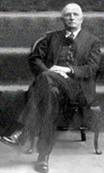
Biografia estratta da: http://www.phys-astro.sonoma.edu
(1887-1957) Henry Norris Russell spent six decades at PrincetonUniversity — as student, professor, observatory director, and active professor emeritus. From 1921 on he also made lengthy annual visits to Mt. Wilson Observatory. He measured parallaxes in Cambridge, England,with A.R. Hinks and found a correlation between spectral types and absolute magnitudes of stars — theHR Diagramm named from Hertzsprung ![]() and Russell. He popularized the distinction between giant stars and “dwarfs” while developing an early theory of stellar evolution. With his student, Harlow Shapley, he analyzed light from eclipsing binary stars to determine stellar masses.
and Russell. He popularized the distinction between giant stars and “dwarfs” while developing an early theory of stellar evolution. With his student, Harlow Shapley, he analyzed light from eclipsing binary stars to determine stellar masses.
Later he and his assistant, Charlotte E. Moore Sitterly, determined masses of thousands of binary stars using statistical methods. With Walter S.Adams Russell applied Meghnad Saha’s theory of ionization to stellar atmospheres and determined elemental abundances, confirming Cecilia Payne-Gaposchkin's discovery that the stars are composed mostly of hydrogen. Russell applied the Bohr theory of the atom to atomic spectra and with Harvard physicist F.A. Saunders made an important contribution to atomic physics, Russell-Saunders coupling (also known as LS coupling). Russell and his Princeton colleagues, R.S. Dugan and J.Q. Stewart, wrote what was for decades the most important astronomy textbook in the United States. Called the “Dean of American astronomers,” Russell was a dominant force in the community as a teacher, writer, and advisor.

